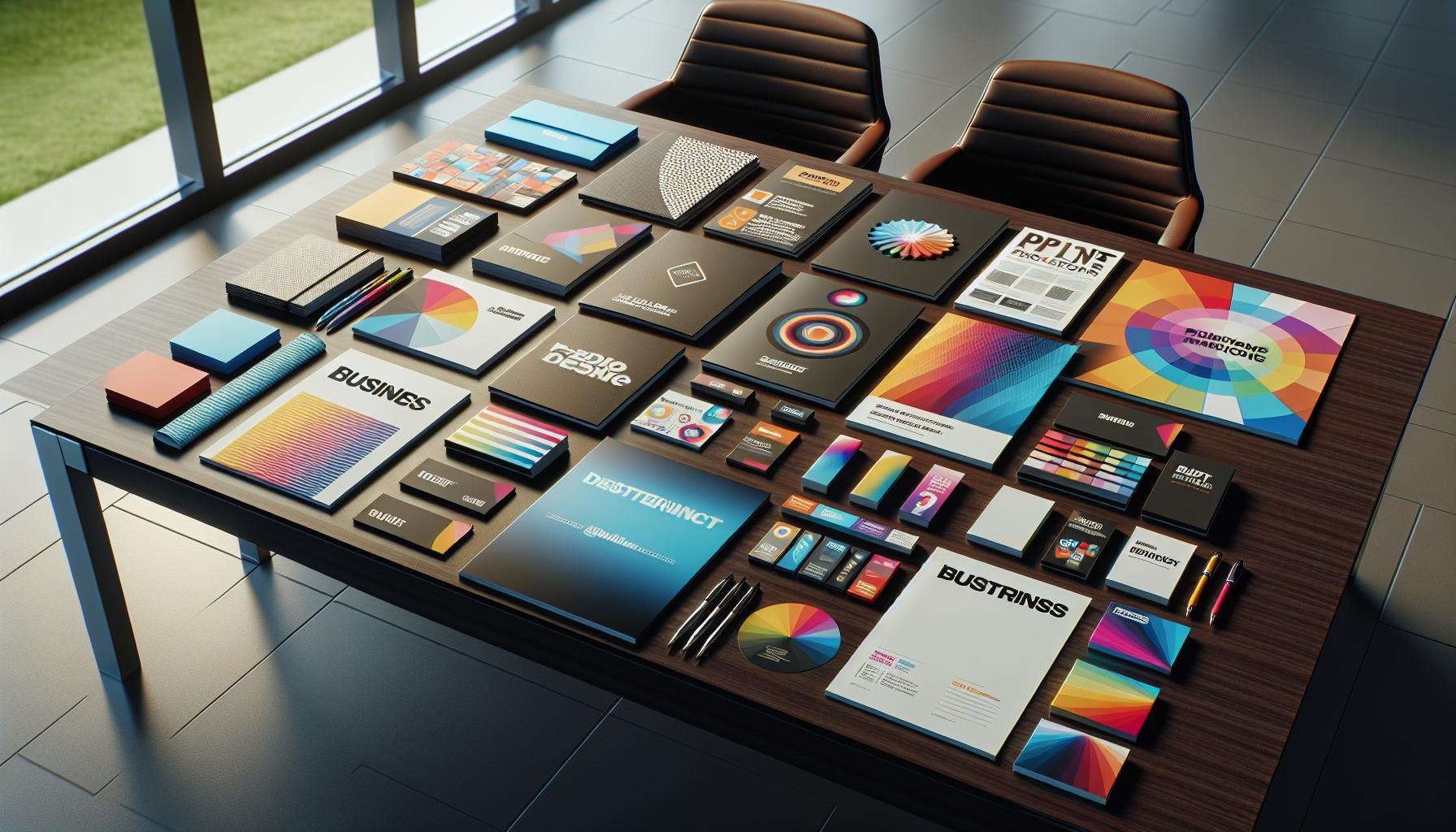In today’s digital age print marketing materials continue to play a vital role in business promotion and brand awareness. From business cards and brochures to banners and promotional flyers these tangible marketing tools create lasting impressions that digital media often can’t match.
Print marketing materials offer unique advantages that make them an essential part of any comprehensive marketing strategy. They provide a physical connection with potential customers building trust and credibility while delivering messages that stick. Studies show that people retain information better when they interact with printed materials compared to digital content. This tactile experience creates a deeper emotional connection making print marketing an invaluable tool for businesses of all sizes.
Why Print Marketing Materials Still Matter in a Digital World
Print marketing materials create tangible connections with customers in ways digital media cannot replicate. Research by the U.S. Postal Service reveals that 67% of consumers prefer physical mail over digital communications for brand messaging.
Studies demonstrate print marketing’s distinct advantages:
| Metric | Print Impact | Digital Impact |
|---|---|---|
| Information Retention | 70% recall rate | 44% recall rate |
| Purchase Influence | 82% trust rate | 51% trust rate |
| Brand Recognition | 75% accuracy | 44% accuracy |
Print materials offer unique benefits in modern marketing:
- Sensory Engagement: Physical materials activate multiple senses through texture paper quality tactile feedback
- Increased Focus: Readers spend 20% more time processing printed content vs digital content
- Reduced Competition: Print materials face less direct competition compared to crowded digital spaces
- Offline Accessibility: Print reaches audiences regardless of internet connectivity or digital device access
Print marketing demonstrates effectiveness across multiple contexts:
- Local Business Promotion: Direct mail campaigns generate 29% higher ROI than digital-only campaigns
- Trade Show Marketing: 85% of exhibitors use printed materials to capture attendee attention
- Brand Development: Companies using print materials report 34% higher brand recognition rates
- Client Relationships: Physical marketing materials increase client trust by 56%
- Screen Breaks: 73% of consumers prefer reading printed materials when taking breaks from digital devices
- Mental Processing: Print content receives 21% less cognitive effort to understand than digital content
- Message Retention: Readers remember 50% more information from print vs digital formats
- Decision Making: Print marketing influences purchasing decisions 70% more effectively than digital ads
Types of Print Marketing Materials

Print marketing materials encompass a diverse range of promotional items designed for specific business objectives. Each type serves distinct marketing purposes with unique advantages for reaching target audiences.
Business Cards and Stationery
Business cards establish professional credibility through personalized contact information presentation. Standard business stationery includes letterheads headers featuring company logos embossed envelopes custom notepads. Premium card stocks with special finishes like spot UV coating metallic foil enhance brand perception generating 23% higher response rates compared to basic designs.
Brochures and Flyers
Brochures deliver detailed product information through bi-fold tri-fold z-fold formats. Marketing flyers feature single-sheet designs highlighting promotional offers event announcements product launches. Studies indicate glossy brochures achieve 85% retention rates while full-color flyers increase response rates by 55%. Common sizes include:
| Format | Dimensions (inches) | Average Response Rate |
|---|---|---|
| Tri-fold | 8.5 x 11 | 4.9% |
| Bi-fold | 11 x 17 | 3.7% |
| Flyer | 8.5 x 11 | 2.9% |
Banners and Posters
Large-format prints create high-visibility marketing displays for events trade shows retail environments. Indoor banners utilize 13oz vinyl materials while outdoor versions feature 18oz weather-resistant vinyl. Standard poster sizes range from 18×24 inches to 27×40 inches printed on 100lb gloss text stock. Research shows strategically placed banners increase foot traffic by 47%.
- 4.4% response rates for postcards sized 4×6 inches or 5×7 inches
- 3.7% engagement for personalized catalogs featuring 8-32 pages
- 5.1% conversion rates for promotional letters in standard #10 envelopes
- 6.6% return rates for dimensional mailers incorporating samples promotional items
Designing Effective Print Marketing Materials
Professional print marketing design combines visual elements with strategic messaging to create compelling materials that drive engagement. Studies show that well-designed print materials increase response rates by 40%.
Choosing the Right Colors and Typography
Color psychology influences 85% of consumer purchasing decisions in print marketing materials. The optimal color combination includes 2-3 primary colors with 1-2 accent colors for maximum impact. Typography hierarchy employs 3 distinct font styles: headlines use bold sans-serif fonts at 24-36pt, subheadings utilize medium-weight fonts at 16-20pt, and body text features serif fonts at 10-12pt for readability.
| Color Elements | Impact on Response Rates |
|---|---|
| Full Color | +55% |
| Two-Color | +40% |
| Single Color | +20% |
| Black & White | Baseline |
- Logo placement in the top-left or center position
- Corporate colors matched to Pantone standards
- Consistent font families across all materials
- Standard margins of 0.5-1 inch on all sides
- Unified graphic elements like icons or patterns
- Regular spacing between design elements
- Quality paper stock selection based on purpose
| Brand Element | Recognition Rate |
|---|---|
| Logo | 75% |
| Color Scheme | 65% |
| Typography | 45% |
| Layout | 40% |
Print Quality and Paper Selection
Print quality and paper selection form the foundation of impactful marketing materials, with studies showing that high-quality prints increase engagement rates by 43% compared to standard alternatives. Strategic paper choices and premium printing methods create lasting impressions that reinforce brand credibility.
Paper Types and Weights
Print marketing materials utilize specific paper types based on their intended purpose. Bond paper (20-28 lb) serves as the standard for letterheads letterheads stationery. Text paper (50-100 lb) provides optimal readability for brochures catalogs newsletters. Cover stock (65-130 lb) delivers durability for business cards postcards presentation folders.
Paper characteristics impact marketing effectiveness:
- Coated papers enhance image vibrancy increasing color saturation by 35%
- Uncoated stocks create a natural feel improving tactile engagement by 28%
- Textured papers boost brand recall rates by 24% over smooth alternatives
- Recycled papers appeal to eco-conscious audiences with 31% higher response rates
Printing Methods and Finishes
Different printing methods produce distinct visual results affecting marketing impact:
| Printing Method | Color Accuracy | Cost per 1000 | Best Applications |
|---|---|---|---|
| Digital | 92% | $45-85 | Short runs, variable data |
| Offset | 98% | $85-150 | Large quantities, premium quality |
| Screen | 95% | $150-300 | Specialty materials |
- UV coating increases durability by 75% extending marketing lifetime
- Spot varnish highlights key elements improving focus areas by 42%
- Embossing creates dimensional effects raising engagement rates by 38%
- Foil stamping adds metallic elements increasing perceived value by 45%
Distribution Strategies for Print Marketing
Print marketing distribution requires strategic planning to maximize reach and engagement. Studies indicate targeted distribution strategies increase response rates by 48% compared to general distribution methods.
Target Audience Segmentation
Demographic segmentation divides audiences into specific groups based on measurable characteristics:
- Geographic targeting focuses on specific neighborhoods with direct mail campaigns reaching 98% of households
- Age-based distribution targets locations frequented by specific age groups such as senior centers or universities
- Income-level targeting aligns premium materials with high-income neighborhoods showing 35% higher response rates
- Interest-based distribution places materials at relevant venues like fitness centers for health products
- Business sector targeting reaches professional audiences through chamber of commerce events generating 42% more leads
- Response tracking uses unique QR codes showing scan rates of 12.5% for targeted campaigns
- Redemption rates measure coupon usage revealing 23% higher returns for segmented distributions
- Conversion tracking implements specific promotion codes generating 8.4% response rates
- Geographic performance analysis identifies high-performing zones with 45% better engagement
- ROI calculation compares distribution costs against revenue showing 3.7x return for targeted campaigns
| Metric | General Distribution | Targeted Distribution |
|---|---|---|
| Response Rate | 2.9% | 4.3% |
| Redemption Rate | 1.8% | 2.2% |
| Lead Generation | 3.2% | 4.5% |
| ROI | 2.1x | 3.7x |
Cost Considerations and ROI
Print marketing material costs vary based on quantity, quality specifications, design complexity and distribution methods. A comprehensive cost analysis includes:
Production Expenses
- Design fees range from $500-$2,500 for professional brochure layouts
- Printing costs average $0.03-$0.25 per page for standard materials
- Premium finishes add 15%-40% to base printing costs
- Setup fees typically range $50-$200 per print job
Return on Investment Metrics
| Marketing Material | Average ROI | Response Rate |
|---|---|---|
| Direct Mail | 112% | 4.9% |
| Brochures | 95% | 3.7% |
| Business Cards | 85% | 2.5% |
| Catalogs | 140% | 4.3% |
Cost-Saving Strategies
- Bulk ordering reduces per-unit costs by 25%-40%
- Standard paper stocks cost 30% less than premium options
- Digital printing saves 15%-25% on short runs under 500 pieces
- Print-on-demand eliminates storage costs
- Targeted distribution reduces waste by 35%
ROI Tracking Methods
- Unique QR codes track response rates
- Custom phone numbers monitor call volume
- Promo codes measure conversion rates
- Geographic response tracking identifies profitable areas
- A/B testing optimizes design elements
| Distribution Method | Cost Per Lead | Conversion Rate |
|---|---|---|
| Direct Mail | $51.40 | 5.1% |
| Door Hangers | $43.90 | 4.2% |
| Trade Show | $70.30 | 6.1% |
| Local Events | $38.50 | 3.9% |
Regular monitoring of these metrics enables data-driven decisions for future print marketing investments, optimizing both cost efficiency and campaign effectiveness.
Conclusion
Print marketing materials continue to deliver exceptional results in today’s digital landscape. The data speaks volumes – with higher recall rates customer trust and brand recognition compared to digital alternatives. From business cards to catalogs these tangible marketing tools create lasting impressions and drive meaningful engagement.
The proven ROI metrics impressive response rates and enhanced brand credibility make print materials an indispensable part of any comprehensive marketing strategy. When combined with strategic distribution methods and quality design elements print marketing stands as a powerful tool for businesses looking to make a lasting impact in their market.
Investing in high-quality print materials isn’t just about maintaining tradition – it’s about leveraging a proven marketing channel that continues to deliver measurable results and foster genuine connections with target audiences.

